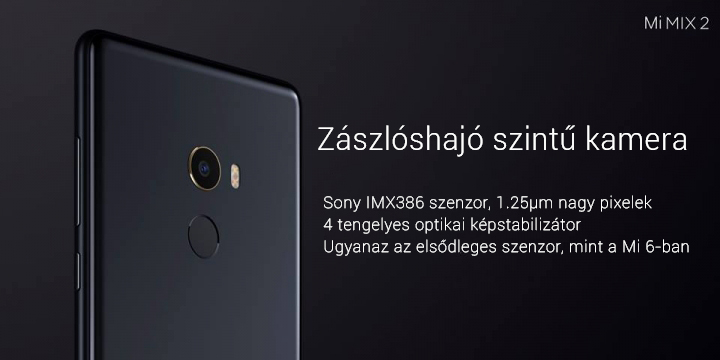Yesterday, Xiaomi unveiled the second generation of its Mi MIX phone, which was still a concept last year. While Xiaomi Mi MIX2 has changed in almost every aspect (screen size, aspect ratio, SoC...), there is one feature that reminds us of its predecessor. And that is the single main camera. Nowadays, it's fashionable (almost a must-have "extra") to have a dual camera in flagships. Its first essential role was to better reproduce depth of field and increase the speed of focus. Some manufacturers use a colour and a monochrome sensor, which can be used to produce beautiful black and white images with the secondary (mono) sensor. Many manufacturers consider this feature superfluous, preferring instead to increase the angle of view of the secondary camera (leaving the colour sensor), thus achieving a true optical zoom effect.
Xiaomi did the same with the Mi6, where one lens got an extra wide angle of view with optical image stabilization, while the second lens got a telephoto lens without OIS.
Many expected the trend to be perpetuated with MIX2, but despite rumours, it was not.
The Xiaomi Mi MIX2 is the camera is almost identical to its predecessor. At first glance, this can be seen in the design. The single lens is in the same place (which, in the SE version, is also gold-plated), and the location and shape of the two-tone flash is unchanged.
The Xiaomi Mi MIX2 with a 12MP Sony IMX 386-sensor, 1.25 μm sizes, with 4-axis optical image stabilisation equipped.
But what if Xiaomi sees that one strong sensor can take better pictures than two weaker ones? Are the images better?
We have to say yes. Engineers have nothing to be ashamed of.
Xiaomi Mi MIX2 camera - stunning images with 4-axis OIS
As you can see, many flagships lack OIS. The Samsung Note8 is an exception, of course, where the camera is equipped with double OIS (a world first).
However, 4-axis OIS is not widespread, and instead the motion sensor of secondary cameras is used for sharpness and image stabilisation.
Another common (simpler) solution is EIS (electronic image stabilisation). With dual cameras, one lens gets this, yet the other is omitted.
This solution ruins the whole dual camera operation, especially for videos during recording.
A single camera, especially the 12MP Sony IMX 386, 1.25 μm size, it can easily compete with other flagships using dual cameras.
Unfortunately, the aperture value has fallen back compared to expectations, and is now considered almost mediocre. f/2.0.
Xiaomi could have achieved higher resolution if it hadn't opted for a single main camera.
Many people are of the opinion that the Mi Note3 is much better than the Mi MIX2 in terms of camera performance. This is only a small improvement over its predecessor (MIX). Perhaps the dimensions were the reason why they spared the dual sensor application, as they needed the space for the integrated high-power 50mW speaker + sound guide tube alongside the hidden ultrasonic proximity sensor. The Cantilever piezoelectric ceramic acoustic technology already takes up enough space.
Surprisingly, the Xiaomi Mi MIX2 test photos did not disappoint, as you would expect from the camera specs. A 4-axis OIS saved the Xiaomi.
Xiaomi Mi MIX2 sample images
Here are the sample photos:
As you can see, the images are quite sharp and the contrast is perfect. The images have a natural look. Low light and shadow performance are also satisfactory.
The best part is that the quality of the pictures is great, even with dual cameras. For proof, you can clearly see the ripples in the water.
Conclusions
To be honest, the camera's hardware is not up to the standard you'd expect from a high-end flagship like the Xiaomi Mi MIX 2. However, the camera's test images are adequate. If you want a Xiaomi phone with a good camera, consider the new Xiaomi Mi Note 3, which has the best dual-camera configuration of any Xiaomi smartphone.The MIX2 won't make a name for itself with its camera, but that wasn't the intention. Further "proof" is that the selfie camera sensor is only 5MP, while the Note3.é is 16MP, with plenty of software add-ons.






















